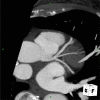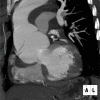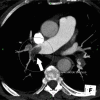Coronary computed tomographic angiography (CCTA) in community hospitals: "current and emerging role"
- PMID: 20531948
- PMCID: PMC2879291
- DOI: 10.2147/vhrm.s9108
Coronary computed tomographic angiography (CCTA) in community hospitals: "current and emerging role"
Abstract
Coronary computed tomographic angiography (CCTA) is a rapidly evolving test for diagnosis of coronary artery disease. Although invasive coronary angiography is the gold standard for coronary artery disease (CAD), CCTA is an excellent noninvasive tool for evaluation of chest pain. There is ample evidence to support the cost-effective use of CCTA in the early triage process of patients presenting with chest pain in the emergency room. CCTA plays a critical role in the diagnosis of chest pain etiology as one of potentially fatal conditions, aortic dissection, pulmonary embolism, and myocardial infarction. This 'triple rule out' protocol is becoming an increasingly practicable and popular diagnostic tool in ERs across the country. In addition to a quick triage of chest pain patients, it may improve quality of care, decrease cost, and prevent medico-legal risk for missing potentially lethal conditions presenting as chest pain. CCTA is also helpful in the detection of subclinical and vulnerable coronary plaques. The major limitations for wide spread acceptance of this test include radiation exposure, motion artifacts, and its suboptimal imaging with increased body mass index.
Keywords: angiography; aortic dissection; calcium scoring; chest pain; community hospitals; computed tomography; coronary CTA; coronary artery disease (CAD); emergency room; pulmonary embolism.
Figures




Similar articles
-
Associations between routine coronary computed tomographic angiography and reduced unnecessary hospital admissions, length of stay, recidivism rates, and invasive coronary angiography in the emergency department triage of chest pain.J Am Coll Cardiol. 2013 Aug 6;62(6):543-52. doi: 10.1016/j.jacc.2013.04.040. Epub 2013 May 15. J Am Coll Cardiol. 2013. PMID: 23684682
-
Use of multislice CT for the evaluation of emergency room patients with chest pain: the so-called "triple rule-out".Catheter Cardiovasc Interv. 2008 Jan 1;71(1):92-9. doi: 10.1002/ccd.21398. Catheter Cardiovasc Interv. 2008. PMID: 18098208 Review.
-
Cost and resource utilization associated with use of computed tomography to evaluate chest pain in the emergency department: the Rule Out Myocardial Infarction using Computer Assisted Tomography (ROMICAT) study.Circ Cardiovasc Qual Outcomes. 2013 Sep 1;6(5):514-24. doi: 10.1161/CIRCOUTCOMES.113.000244. Epub 2013 Sep 10. Circ Cardiovasc Qual Outcomes. 2013. PMID: 24021693 Free PMC article.
-
The CT-STAT (Coronary Computed Tomographic Angiography for Systematic Triage of Acute Chest Pain Patients to Treatment) trial.J Am Coll Cardiol. 2011 Sep 27;58(14):1414-22. doi: 10.1016/j.jacc.2011.03.068. J Am Coll Cardiol. 2011. PMID: 21939822 Clinical Trial.
-
Cardiac computed tomography in the rapid evaluation of acute cardiac emergencies.Rev Cardiovasc Med. 2010;11 Suppl 2:S35-44. doi: 10.3909/ricm11S2S0003. Rev Cardiovasc Med. 2010. PMID: 20700101 Review.
Cited by
-
Coronary Computed Tomographic Angiography Imaging as a Prognostic Indicator for Coronary Artery Disease: Data from a Lebanese Tertiary Center.Heart Views. 2020 Oct-Dec;21(4):239-244. doi: 10.4103/HEARTVIEWS.HEARTVIEWS_87_20. Epub 2021 Jan 14. Heart Views. 2020. PMID: 33986921 Free PMC article.
-
Computed tomography diagnosis of myocardial infarction in a patient with normal initial cardiac biomarkers.Emerg Radiol. 2012 Jan;19(1):75-8. doi: 10.1007/s10140-011-0987-y. Epub 2011 Oct 1. Emerg Radiol. 2012. PMID: 21960208 No abstract available.
-
The feasibility of 1-stop examination of coronary CT angiography and abdominal enhanced CT.Medicine (Baltimore). 2018 Aug;97(32):e11651. doi: 10.1097/MD.0000000000011651. Medicine (Baltimore). 2018. PMID: 30095622 Free PMC article.
-
Coronary CT angiography and serum biomarkers are potential biomarkers for predicting MACE at three-months and one-year follow-up.Int J Cardiovasc Imaging. 2022 Dec;38(12):2763-2770. doi: 10.1007/s10554-022-02646-4. Epub 2022 Aug 8. Int J Cardiovasc Imaging. 2022. PMID: 36445669 Free PMC article.
-
Diagnostic Accuracy of Computed Tomography Angiography as Compared to Conventional Angiography in Patients Undergoing Noncoronary Cardiac Surgery.Heart Views. 2016 Jul-Sep;17(3):88-91. doi: 10.4103/1995-705X.192555. Heart Views. 2016. PMID: 27867455 Free PMC article.
References
-
- Pitts SR, Niska RW, Xu J, Burt CW. National Hospital Ambulatory Medical Care Survey: 2006 emergency department summary. National Health Statistics Reports. 2008;7:20. - PubMed
-
- Flohr TG, McCollough CH, Bruder H, et al. First performance evaluation of a dual-source CT (DSCT) system. Eur Radiol. 2006;16(2):256–268. - PubMed
-
- Dey D, Lee CJ, Ohba M, et al. Image quality and artifacts in coronary CT angiography with dual-source CT: initial clinical experience. J Cardiovasc Comput Tomogr. 2008;2(2):105–114. - PubMed
-
- Fineberg HV, Scadden D, Goldman L. Care of patients with a low probability of acute myocardial infarction. Cost effectiveness of alternatives to coronary-care-unit admission. N Engl J Med. 1984;310(20):1301–1307. - PubMed
-
- McCarthy BD, Wong JB, Selker HP. Detecting acute cardiac ischemia in the emergency department: a review of the literature. J Gen Intern Med. 1990;5(4):365–373. - PubMed
Publication types
MeSH terms
LinkOut - more resources
Full Text Sources
Other Literature Sources
Medical
Miscellaneous

